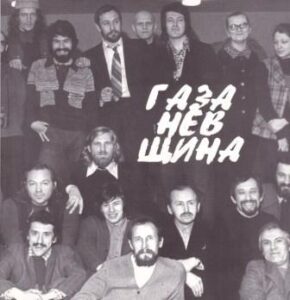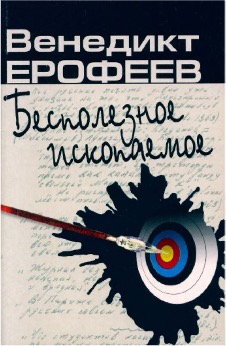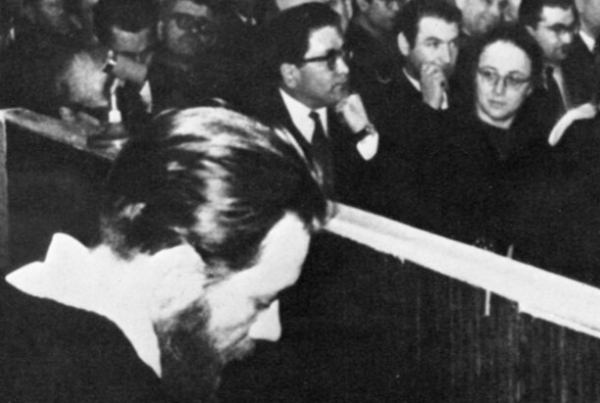
“Gazanvshchina” artists. Leningrad, 1974. Photo by G. Prichod’ko.
Dates: 22-25 December 1974
Place: Leningrad, Dvorets kul’tury imeni I.I. Gaza [Gaza Palace of Culture]
Description:
Before the famous Gazanevskii exhibitions, there were several unofficial displays of art in the USSR in the 1960s. At the State Hermitage Museum on March 30-31, 1964, the Shemiakin group exhibited their art and at the Kozitskii Palace of Culture in 1968-1969 the School of Sidlin staged an exhibition. These small events testify to the activity and vitality of non-conformist artists in Leningrad. In the late autumn of 1974, a group of unofficial artists, led by Iurii Zharkikh, asked the authorities for permission to stage an official, public exhibition of their artworks. Still feeling the repercussions of the “Bulldozer” Exhibition in Moscow, organized by Oscar Rabin, Iurii Zharkikh and Alexander Gleser, on September 15, 1974, the Soviet authorities were forced to grant the artists permission to avoid international scandal. The two events were very different: the “Bulldozer Exhibition” was organised by Nonconformist artists from Moscow and Leningrad in the urban forest of Beliaevo as a political act against the oppressive regime; the exhibition in Leningrad was primarily an artistic event and would be the first legal exhibition of unofficial fine arts. During the 1960s and 70s Soviet art was isolated; only the members of the “Union of Soviet artists” were officially acknowledged at home and abroad. Artists who were not recognised by the state could not sell or exhibit their art or even define themselves as artists. Artists working outside official channels could be arrested and their artworks could be sequestrated and destroyed. However, in this instance, the authorities, under pressure from abroad, allowed unofficial artists to hold an officially sanctioned exhibition.
The event took place at the Gaza Palace of Culture in Leningrad on December 22-25, 1974, only lasting four days. The list of participants included: A. Aref’ev, V. Afanasev, A. Basin, A. Belkin, V. Bogatyrev, G. Bogomolov, L. Bolmat, V. Viderman, Y. Vinkovetskii, V. Gavrilchik, Iu. Galetskii, A. Gennadev, E. Goriunov, E. Gritsenko, F. Gumeniuk, I. Dakinevichuite, Iu. Dyshlenko, E. Esaulenko, Igor’ Ivanov, Ilia Ivanov, Y. Zharkikh, A. Isachev, T. Kerner, G. Zubkov, A. Kozhin, V. Kubasov, B. Kupin, G. Lakin, V. Leonov, N. Liubushkin, T. Mamonova, A. Manusov, E. Zakharova, Y. Nikshiul, V. Mikhailov, V. Ovchinnikov, A. Okun’, V. Permiakov, Iu. Petrochenkov, A. Polushkin, A. Rapoport, I. Ross, V. Rokhlin, E. Rukhin, N. Sazhin, V. Sbitnev, I. Siniavin, V. Smirnov, V. Soloviova, G. Ustyugov, V. Filimonov and V. Shagin. 220 works were displayed by fifty-two non-conformist artists, engendering unforeseen interest (cf. Basin, Skobina 2004: 104-117). Despite the ban on publicising the event, the exhibition clocked up 15,000 visitors and detailed reports circulated in samizdat and the foreign press. This first authorized non-conformist exhibition proved that individual creativity was alive and well in the USSR and symbolised an important emancipation from socialist realism. Different styles were represented including avant garde, primitivism, surrealism and pop-art (cf. Severiukhin 2003: 26-27). The success of the exhibition encouraged Leningrad’s unofficial writers and poets to present the anthology Lepta to the Soviet publishers, Sovetkii pisatel’. Publication was prevented by the Union of Soviet Writers in 1975, however Gazanevshschina and Lepta became crucial moments in the history of unofficial culture in Leningrad (cf. Sabbatini 2020: 188-193, 219-223). In September 1975, a second successful exhibition of Nonconformists from Leningrad took place at the Nevskii culture palace inspiring new exhibitions and informal groups, such as the Fellowship of Experimental Fine Art (TEII). Gazanevshchina undoubtedly changed the course of the Leningrad underground, and with its ironic name, came to stand for independent art of the 1970s and 1980s in the Soviet Union.
Marco Sabbatini
[30th June 2021]
Bibliography
- Basin A., Skobkina L. (eds.), Gazanevshchina, Seriia Avangard – P.O.P., Sankt-Peterburg 2004.
- Dolinin V., Ivanov B., Ostanin B. Severiukhin D. (eds.), Samizdat Leningrada. 1950-e – 1980-e. Literaturnaia ėntsiklopediia, Novoe Literaturnoe Obozrenie, Moskva 2003.
- Sabbatini M., “Quel che si metteva in rima”. Cultura e poesia underground a Leningrado, Collana Europa Orientalis, Salerno 2008.
- Sabbatini M., Leningrado underground. Testi, poetiche, samizdat, WriteUp, Roma 2020.
To cite this article:
Marco Sabbatini, Gazanevshchina, in Voci libere in URSS. Letteratura, pensiero, arti indipendenti in Unione Sovietica e gli echi in Occidente (1953-1991), a cura di C. Pieralli, M. Sabbatini, Firenze University Press, Firenze 2021-, <vocilibereurss.fupress.net>.
eISBN 978-88-5518-463-2
© 2021 Author(s)
Content license: CC BY 4.0





